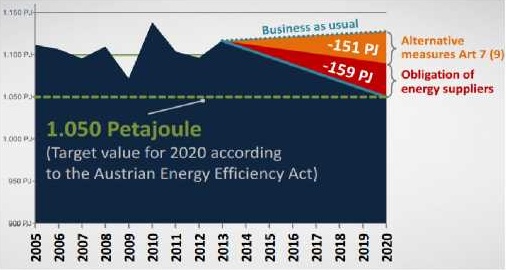Austria will add additional financial means to the existing policy framework to reach their target value for primary energy consumption of 1050 PetaJoule in 2020 (compared to 1120 PJ in 2013). The case study has analysed whether energy efficiency improvement policies lead to overlaps with policies at the level of provincial governments and what this could mean for the effectiveness and efficiency of the policies.
Interactions between energy efficiency policies in the household sector in Austria
In Austria, overall final energy consumption has increased again after the sharp decline in 2009, which was due to the financial crisis and corresponding economic recession. In order to address this trend, Austria’s Energy Strategy, the National Renewable Energy Action Plan (NREAP) and the Energy Efficiency Law have set a target value for primary energy consumption of 1050 PetaJoule in 2020 (compared to 1120 PJ in 2013). In order to achieve this target, Austria will add additional financial means to the existing policy framework. However, there is a risk that these new policy measures overlap with already existing policy measures.
Analysis

The case study has analysed whether energy efficiency improvement policies at the federal government level in Austria could obligation of lead to overlaps with policies at the level of provincial governments and what this could mean for the effectiveness and efficiency of the policies. At the federal government level, several ministries have specific energy-related responsibilities, while at the regional level, the governments of the nine federal provinces have responsibility for policy making, including setting subsidy levels, and implementing regulatory control of energy companies.
The case study analysis concludes that overlaps between federal and regional subsidies for energy efficiency are unavoidable as the scope, instruments and target groups of different subsidy scheme are too often similar. As such, this does not have to be a problem as long as in the design and implementation stages, a detailed fine-tuning of measures takes place. However, in actual practice fine-tuning of federal government energy efficiency policies with all nine provinces is complicated as
the provinces differ from each other in terms of their regional policies and subsidies, based on different priorities, political coalitions and technological as well as socioeconomic boundaries.
Findings
Based on the case study on interactions between energy efficiency policies at different policy levels in Austria, the following is concluded:
- Overlaps between federal and regional subsidies for energy efficiency are unavoidable. The scope, instruments and target groups of different subsidy scheme are too often similar. This could be avoided through a detailed fine-tuning in the policy design and implementation stages, but in actual practice fine-tuning of federal government energy efficiency policies with all nine provinces is complicated
- Overlaps in subsidies and over-subsidisation imply the risk that governmental funds are used inefficiently. As a result, the observed energy savings in households are achieved at relatively high public costs. Moreover, in terms of policy effectiveness, it is not entirely clear whether the observed reduction in household-level energy demand during the past few years can be fully attributed to the subsidy schemes. On the one hand, in terms of energy demand reduction Austria performs better than the EU-average, but this performance may also have been caused by the relatively warm winters of the last years.
- A possible way forward is to design a new target-oriented policy mix that is not entirely based on subsidies, but, for instance, enable combination of energy or environmental standards with subsidies.
The full report will be available soon at: http://carisma-project.eu/Publications/Working-document-series

This article is an output of the EU-funded CARISMA project.
CARISMA
CARISMA project
Project details
- Project title: “Coordination and Assessment of Research and Innovation in Support of climate Mitigation Actions” (CARISMA)
- Funding scheme: European Union Horizon 2020 Programme (EU H2020, grant agreement no. 642242)
- Duration: 3.5 years (1 February 2015 – 31 July 2018)
- Project coordinator: Radboud University, Nijmegen, the Netherlands
- Project website: www.carisma-project.eu


